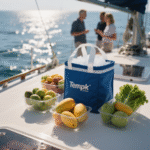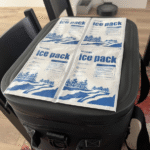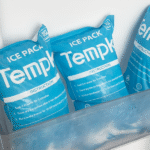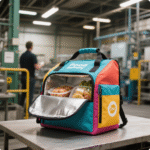When shipping perishable food items, ensuring that they remain fresh throughout the journey is vital. Dry ice packs are increasingly being used to achieve this goal. En 2025, they remain one of the most effective ways to maintain the right temperature, ensuring both food safety and quality. En este artículo, we will explore why dry ice packs are crucial for food shipping, sus beneficios, different types available, and tips on choosing the best supplier for your needs.
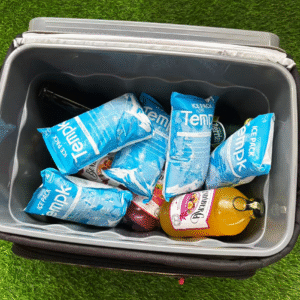
Why Are Dry Ice Packs Important for Food Shipping?
Paquetes de hielo seco are solidified carbon dioxide (Co₂) Ese sublimado (turn directly from solid to gas) at a very low temperature of -109.3°F (-78.5°C). This makes them highly effective in keeping perishable foods frozen or chilled during shipping, without the need for water-based ice that can cause leaks and water damage.
Temperature Control for Safe Food Shipping
Maintaining the right temperature during food shipping is crucial for food safety. Dry ice packs keep food at the desired temperature for extended periods, reducing the risk of bacterial growth, deterioro, and nutrient loss. For food that requires freezing or refrigeration, como la carne, mariscos, y lácteos, dry ice prevents these risks by maintaining an ultra-cold environment.
Preventing bacterial growth: Keeping food at a stable, cold temperature slows bacterial growth, ensuring food safety and extending shelf life.
Enfriamiento duradero
One of the main advantages of dry ice over traditional ice is its ability to maintain sub-zero temperatures for extended durations. Traditional ice melts into water, which can damage packaging and cause contamination. hielo seco, sin embargo, sublimes without leaving any residue, making it ideal for long-distance shipments.
Extended shelf life: Dry ice keeps perishable goods frozen or chilled for longer than regular ice, making it perfect for long-haul deliveries.
Sin residuos de agua
Dry ice’s ability to sublime directly into gas instead of melting into water ensures no moisture is left behind. This eliminates the potential for leaks or water damage, which can harm the food, embalaje, and even the shipping container.
Types of Dry Ice Packs for Food Shipping
There are different types of dry ice solutions tailored for specific food shipping needs:
-
Standard Dry Ice Packs: These are solid pieces of dry ice wrapped in insulation. Ideal for short shipments (arriba a 48 horas) where extreme freezing is required.
-
Insulated Containers with Dry Ice: These containers offer enhanced temperature control and can keep shipments cold for extended periods, perfect for long-distance shipments.
-
Pre-packaged Dry Ice Sheets: Customizable sheets designed to line containers and provide even temperature control across the shipment. These are great for specialized food shipments, such as delicate items like seafood or frozen meals.
Each type of dry ice solution serves a different purpose, so it’s essential to select the right one based on the specific needs of your shipment, including the type of food and duration of transit.
How Long Can Dry Ice Keep Food Cold During Shipping?
The duration for which dry ice keeps food cold depends on various factors such as the amount of dry ice used, the insulation quality of the packaging, and external temperature conditions. Generalmente:
-
Short Shipments (1-3 días): Standard dry ice packs can keep food frozen for up to 48 horas, making them suitable for short-distance or expedited deliveries.
-
Longer Shipments (3-7 días): Para envíos más largos, insulated boxes with larger amounts of dry ice are necessary to maintain the required temperature.
Some suppliers also provide temperature monitoring services to ensure that food remains at the correct temperature throughout transit.
Benefits of Using Dry Ice Packs for Food Shipping
1. Extended Cooling Power
Dry ice packs last significantly longer than regular ice, maintaining sub-zero temperatures for longer, which is essential for shipping frozen goods over long distances.
2. Non-Melting
A diferencia del hielo normal, which turns into water and can cause leaks or damage, dry ice sublimates and leaves no liquid behind. This ensures your food is safe and dry during transport.
3. Seguro y no tóxico
Dry ice is a safe, non-toxic material, but it must be handled properly to avoid mishaps. Correct storage and ventilation are key to ensuring safety during shipping.
How to Choose the Best Dry Ice Supplier for Food Shipping in 2025
When selecting a supplier for dry ice packs, considere los siguientes factores:
-
Quality and Compliance: Ensure the supplier meets industry standards for food safety and dry ice handling.
-
Packaging Options: Choose a supplier offering customized solutions for various types of food and different shipping durations.
-
Experience and Reputation: Opt for a supplier with a proven track record in handling perishable goods and providing reliable delivery services.
-
Sostenibilidad: With increased awareness of environmental issues, some suppliers focus on eco-friendly practices, such as using sustainable packaging and carbon offset initiatives.
Hielo seco vs. Hielo regular: Which Is Better for Food Shipping?
Hielo seco is typically better for shipping frozen foods or long-distance shipments due to its extended cooling power and non-melting properties. Hielo regular, sin embargo, is better suited for shorter shipments or situations where food only needs to be kept cool rather than frozen.
| Característica | Hielo seco | Hielo regular |
|---|---|---|
| Mejor para | Long-distance, frozen food shipments | Shorter shipments, cooling rather than freezing |
| Duración del enfriamiento | Arriba a 7 días | A few hours |
| Water Residue | Ninguno (se sublima en gas) | Can melt into water |
How to Safely Handle Dry Ice During Food Shipping
Dry ice is extremely cold and must be handled with care. Here are some important safety tips:
-
Ventilación adecuada: Ensure containers are vented to allow the carbon dioxide gas to escape and prevent pressure buildup.
-
Protective Gear: Always use gloves or tongs when handling dry ice to avoid frostbite.
-
Almacenamiento: Store dry ice in well-ventilated areas, lejos de las fuentes de calor, to avoid rapid sublimation.
Common Mistakes to Avoid When Shipping Food with Dry Ice
-
Incorrect Amount of Dry Ice: Using too little dry ice can cause the food to thaw, while too much can lead to unnecessary costs and may cause sublimation issues.
-
Poor Insulation: Insufficient insulation causes dry ice to lose cooling power quickly. Always use high-quality insulation materials.
-
Ignoring Regulations: El hielo seco se clasifica como un material peligroso, so it’s essential to comply with shipping regulations and guidelines to avoid fines or delays.
Conclusión
En 2025, dry ice packs remain one of the best solutions for shipping food safely. By selecting the right dry ice pack for your needs, ensuring proper handling, and choosing a reliable supplier, you can guarantee that your food shipments will arrive fresh, seguro, y a tiempo. Keep in mind the different types of dry ice packs available, and follow the recommended practices for optimal food preservation.
















